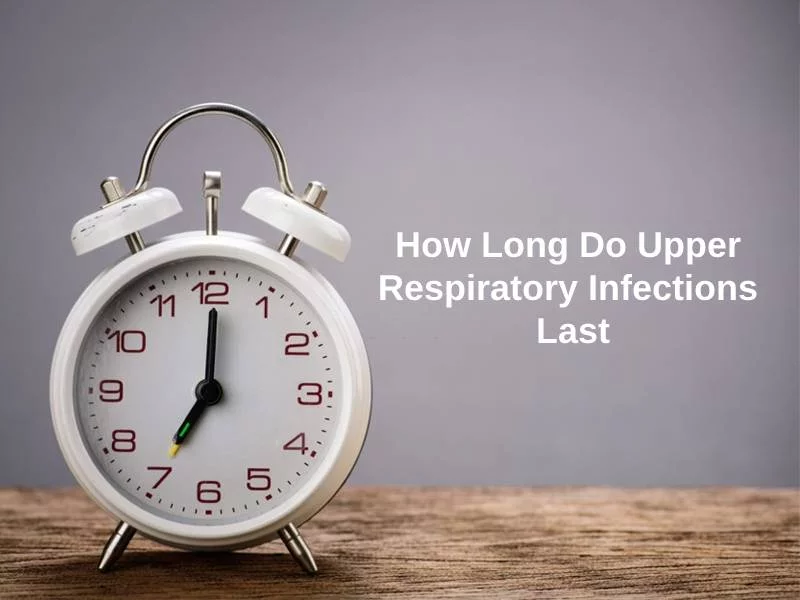Exact Answer: 1-2 Weeks
The infection of the respiratory system is of two types the upper respiratory infection and lower respiratory infection.
Upper Respiratory Infections are types of viral infections; It is also called URTI. This type of reaction affects the upper organs of the respiratory system, which are the nose, throat, and airway.
The infection occurs when any microorganism, particularly, a virus enters the respiratory system. The URTIs are infectious diseases, which means; that they can easily pass by touching, coughing, and especially while sneezing.
Epiglottitis, Laryngitis, Pharyngitis (sore throat), and Sinusitis (sinus infection) are a few upper respiratory infections. The common cold is the most common URTI.

How Long Do Upper Respiratory Infections Last?
| Age Group | Time |
| Children | 4-10 Days |
| Adults | 3-14 Days |
In children of 3 to 6 years of age group URTIs last for around 4 to 10 days; When in adults, it can last 3 to 14 days. But if it lasts longer; so it is advised to visit the doctor. The maximum number of cases in the hospital are of Upper Respiratory Infections.
Upper respiratory infections are the most common diseases; they are more common than lower respiratory infections; globally, approximately millions of people suffer from URTIs every year.
More than 90% of URTIs are the result of viral infection. A few times, it can be because of bacterial infection. They spread very quickly as most URTIs are contagious.
URTIs are easy to diagnose, with some common symptoms like cold, sneezing, stuffy nose, cough; you can detect it. That lasts for 2 to 3 weeks. In some cases, you can see some symptoms of tonsil irritation, sore throat, fatigue, and fever.
You can treat URTIs yourself, which is why there are known as self-treatable diseases; Resting and keeping the body hydrated by drinking more fluid helps relieve some symptoms; More prescribed medicine for cold also works.
The common cold doesn’t require antibiotics or antimicrobial drugs. In some complicated cases, you should consult with the doctor. The pathogen called Rhinoviruses causes the common cold.
Why Do Upper Respiratory Infections Last That Long?
Crowded and unhygienic places increase the chances of getting upper respiratory infections; reportedly, around 5 to 15% of the population gets infected by respiratory infections; and the maximum of them are due to viral infection.
The URTIs are more common in children than in adults as they are more likely to get in touch with other infected children. Although children’s immune system responds quickly to pathogens(viruses and bacteria), children get better in a week.
People with diseases like heart and lung disease are at high risk of getting an Upper respiratory infection. Their respiratory system can get an infection quickly; those with a weak immune system can get respiratory infections.
Upper respiratory infections occur when foreign particles enter the respiratory tract. Foreign particles are commonly known as pathogens; They can enter the body by any; type of contact with the patient, like touching, coughing, or sneezing.
There are many physical barriers present in our body to stop pathogens from entering. Hair, wet mucus present in the Nasal cavity engulfs the foreign particle and pathogens; moreover, the immune system also attacks the pathogen to stop them from entering.
After all these berries, some microorganisms find their way into our body and cause infection by using a disturbance and producing toxins.
Conclusion
The pathogens like Diphtheria, Rhinoviruses, Streptococci, Respiratory syncytial virus (RSV) cause upper respiratory infections; every microorganism has its way of infecting, and because they are different from each other. Every respiratory infection requires a different kind of treatment.
URTIs show some common symptoms of cold, cough, fever, other symptoms like loss of smell, post-Nasal drip, soreness; if the infection lasts longer than 10-days, in critical situations visiting a doctor and seeking a professional opinion is advised.
Smoke, stress, sleeping problems, unhygienic, damaged respiratory organs like damaged airways, and more time spent at a crowded place can increase the chances of respiratory infection.